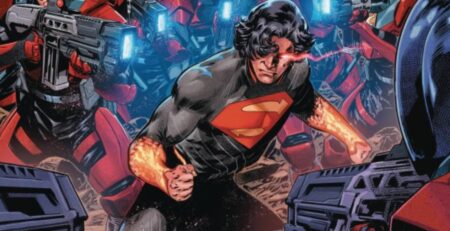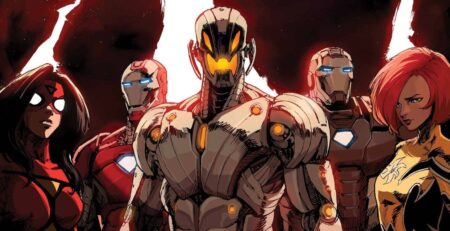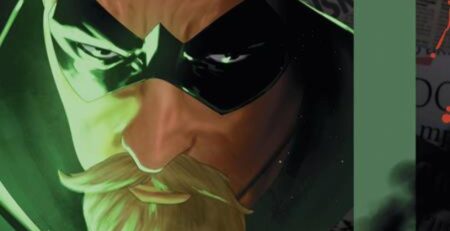Wonder Woman #5 is published by DC Comics, written by Tom King, art by Daniel Sampere, colors by Tomeu Morey, and letters by Clayton Cowles. There is a backup story titled “World’s Finest Part 3,” written by King, art by Belén Ortega, colors by Alejandro Sánchez, and letters by Cowles. Wonder Woman speaks with all of the younger Amazons as the Sovereign gathers an army of her greatest enemies.
King likes to split his plots between two stories, and Wonder Woman #5 is another example of that. A rhythm is built within the issue, alternating between Wonder Woman and her former sidekicks and Sergeant Steel paying each of the villains a visit. It allows the book to develop a stride. With a book with so much dialogue and conversation, it is important to establish a pace so the comic doesn’t get bogged down within itself. This is another issue that lacks fighting but is made up for with three very different scenarios that Wonder Woman has. Each with a different hero: Donna Troy, Yara Flor, and Cassie.
These are fun situations, contests between the older hero and those she helped train. The reason for each challenge works well with the alternate story. One is trying to subtract allies, while the other attempts to add them. And, while there isn’t any action, the segments with each of the Wonder Girls provide the issue with small sparks of energy. The ending could have been seen coming long before the final page, but the moment is powerful enough to supersede its predictability.
The characters are interesting within this issue, as it is one of the first instances of the wider world of Wonder Woman making an appearance within King’s run. Many aspects of the supporting cast are expanded on at the same time. Those that Wonder Woman has considered as younger sisters or even daughters at points are brought back as the danger surrounding Diana grows.
The dialogue between them varies, showing the intricacies of King’s scripts. But one of the consistencies is the idea that the girls are finding something they can best Wonder Woman. All of them have the idea that Wonder Woman’s age may be a factor in them getting the better of her. But the individual conversations between hero and former sidekick are genuine and heartwarming. They know each other so well, and you get glimpses of their history. With each of the young women, the older reveals how they have affected and changed her.
Alternatively, there is an enormous recruitment drive through Wonder Woman’s rogue’s gallery. Some have been an adversary for decades, and others are more recent. But all of them are given a page of their own. There are two for every segment before the scene changes to Wonder Woman. There is a long, narrated monologue for each villain, one that discusses how nefarious they are and how easy it was to procure them. It will be another issue before you get to know what planes they have and how dangerous they will be. But King gives them the space to capture their personalities instead of just forcing them into a room with no preamble.
The art is gorgeous, as always. Each character is represented in this ultra-realistic style that Sampere brings to the book. There is exquisite beauty on every page. With each villain’s introduction comes a completely unique location and setting. One may be trapped within a prison, incarcerated for their own good, whilst others live a more peaceful life. What is also interesting is how the competitions between Wonder Woman and her companions are changed through the art style. Some have more movement than others, and each one is a visual delight. The last is especially brilliant. It features a direct reference to another DC property, with enough detail to make it obvious exactly what Sampere and King are using. Seeing it in all its glory, with so much specificity, is amazing and serves as a hilarious final challenge.
The colors are stunning. The natural shades used all over the issue are the norm until they don’t need to be. The vibrancy comes from the characters and their costumes, especially the heroes. But the transition between tones is seamless and almost unrecognizable within the comics. The lettering in the word balloons is still superb, but the caption boxes still have an awkward color scheme.
The backup story is another adorable adventure with the younger trinity in another timeline. It’s a brilliant bit of fun with three incredibly energetic characters. The art superbly captures them growing whilst still being kids at the same time. You have Jon in his Superman costume and Damian as Batman, fully realised versions of their dreams. But there are glimmers and suggestions that things aren’t right within these idyllic scenes, and those brief moments are captivating. They often require a double-take, as small comments could easily be passed off and ignored.
Wonder Woman #5 brings everyone else to the party. The first four issues of this series were so centred on Wonder Woman and her reaction to the extreme pushback by the American Government. She is the star of the show, and this is still clearly the case here as well. Wonder Woman wants to deal with everything on her own, but this chapter shows who can help her, as well as the main reason why. It could be considered slow, but the action has been replaced with some fantastic pieces of character development and storytelling. The art is glorious and turns any scene that could be considered mundane into one of visual splendor.
Wonder Woman #5 is available where comics are sold.
Wonder Woman #5
TL;DR
Wonder Woman #5 brings everyone else to the party. Wonder Woman wants to deal with everything on her own, but this chapter shows who can help her, as well as the main reason why. It could be considered slow, but the action has been replaced with some fantastic pieces of character development and storytelling.





